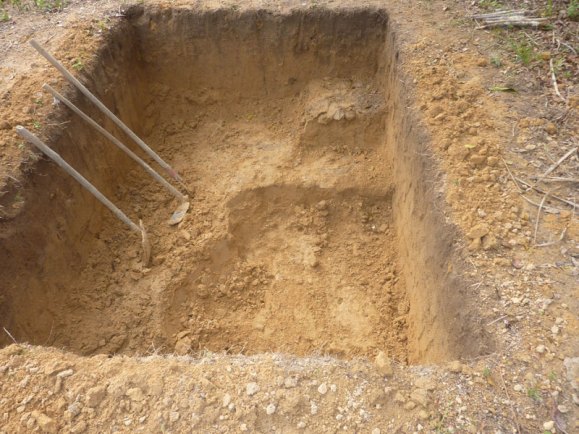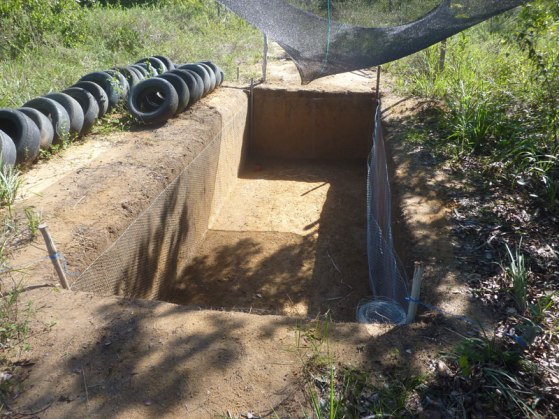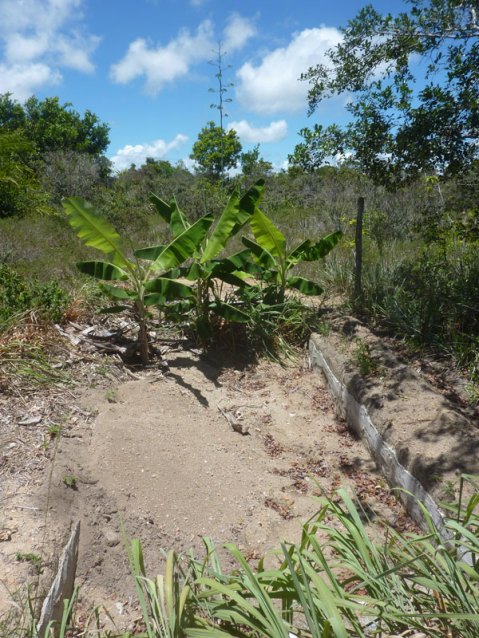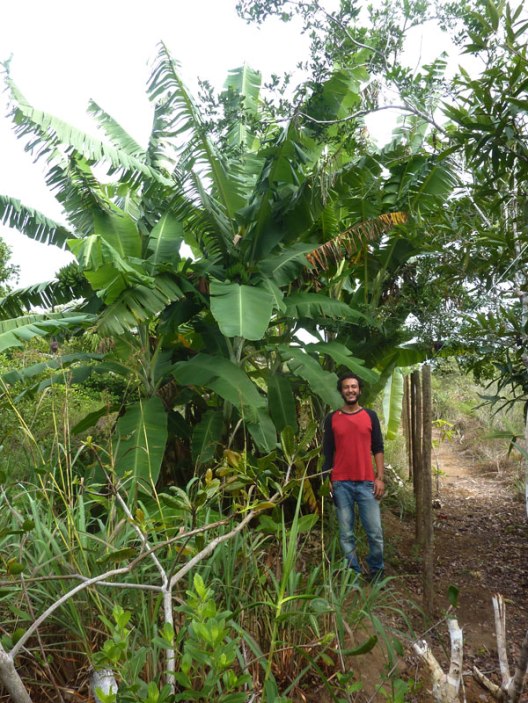This technique uses 4 sustainable practices;
– Brown water recycling
– Low environmental foot print for tank construction with ferro-cement technique
– Old tires recycling
– Building material recycling
The cost of such a biodigestor is very low (less than 3 bags of cement, less than 1m3 of sand, 24 meters of chicken wire by 1 m high, transportation of 8 m3 of concrete building material waste) for a tank of 10 m3.
The goal is to create a close chamber to gather brown water as a nutrient for Banana trees and other tropical edible plants liking humidity and fertility. The bacteria decompose the brown water to produce edible nutrients for the plants. The tank is hermetic so the system is closed and all polluted water is recycled. The different variations of construction found on the net show either a chamber made with bricks and cement (this one is made with recycled tires) or a tank made in a classical way with cement blocks. The construction process described here is the best of breed (lower environmental impact) of these different techniques.
Here is the construction process of a Biodigestor – evapo-transpiration with pictures;
 |
Making a hole 1 m deep, 2 m large. The length depends on the capacity you wish to setup.
The ratio is 1 m length for 1 inhabitants using the WC (e.g 10 people = 10 m long).
 |
Positioning the chicken wire which will be use as the armature of cement (ferro-cement technique).
This technique reduce the need for cement (only 3 bags of cement will be used here and no block of concrete).
 |
the wire is elevated from the floor and pushed away from the wall (1 cm)
in order to be entirely embedded in the cement.
The first step is cementing the floor.
 |
Once the tank is done the recycled tires are positioned
in order to form a large tube corresponding to the main chamber of bio-digestion of brown water.
The pipe from the WC is connected to one extremity of the large tube made of tires.
 |
The next phase consist in filling the tank with stones or blocks of concrete (recycling building materials)
with the biggest on the bottom and the smallest on upper layers.

Pipes are settled for further maintenance (inspection of the water levels and composition)

A layer of rock dust recover the small blocks or gravels.
You may observe the state of the banana trees planted here
to compare them with their evolution on the next photos.

Dirt is added as the last layer where will be planted the banana trees, papayas
and other plants liking humidity.

After only 3 months the banana trees thrive.

After 6 month they reach a respectable size, continue to grow and propagate.
Only 33% of the surface is filled in waiting to gather silt and sand from a swale for the top layer.
We may expect here 40 thriving banana trees in fine with a fair production of bananas !!!

After 10 to 11 months the banana trees reach an adult size with 3 banana bunches.
Ozgur, in the photo is 6 feet high

Bunch of bananas getting more gorgeous day after day.

Papaya and chuchu (Chayote) do not really work here with the test being done.
The design (schema at the top of the page) was found from Rede Permear, a brazilian ONG.
A critical point is to make sure that the tank is protected from water overflow from the land. This can be done by elevating the tank border or by creating a mount around the tank with vegetation (e.g. Citronela in our example) to prevent erosion (lower foot print solution).
The main labor was to dig the hole manually and to sort the building waste by size for the different layers. The top layer (dirt) was a mix of small concrete gravels, concrete dust and dirt. We may assume the composition of this dirt to play an important role in plant growth having a lot of minerals made certainly quickly edible for plants take thanks to the high level of bacterial activity.
A source of carbohydrate
The biodigestor is to be considered as part of a large biological cycle and the banana trunks when removed after banana harvesting do not need to be recycled inside the biodigestor but used in other parts of the farm, assuming that the incoming flow of brown water is continuous. The biodigestor is both a food producer (banana) and organic matter transformer and cleaner (brown water transformed into banana trunk and leaves). Banana trunks can be chopped as mulch material or used to plant cassava or yam in dry parts of the farm. Then a hole is made in the soil, the size of the trunk log, the log is put in the hole and the cassava cutting directly planted in it. The trunk will be a reserve of nutrient and hold humidity for a long time.
